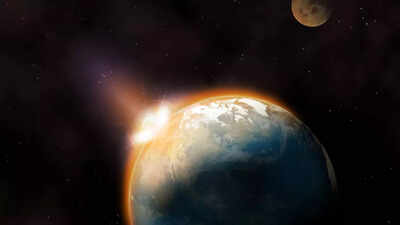Interstellar objects moving through the Solar System represent a rare but scientifically valuable population of visitors that originate beyond the Sun’s gravitational reach. Their potential to collide with Earth, although extremely low in absolute terms, has attracted renewed attention as astronomers refine models that predict their paths, entry points and likely impact characteristics. Advances in computational methods now allow researchers to simulate vast numbers of hypothetical trajectories, creating a clearer picture of where these objects tend to arrive and which regions of Earth are statistically more exposed. This emerging understanding is important because it helps scientists interpret unusual meteor events and assess long-term planetary impact risks without exaggeration or speculation.A detailed model of these behaviours was recently presented in Astrophysics, which used more than ten billion simulated trajectories to estimate the paths of approximately thirty thousand potential impactors.
What the approach direction of an interstellar object reveals about its journey
The simulations show that interstellar objects do not approach Earth uniformly from all parts of the sky. Instead, there is a marked concentration of radiants in two dominant directions, both linked to the motion of the Solar System through the galaxy. A significant proportion of impactors arrive from the solar apex, the direction in which the Sun moves relative to its local stellar neighbourhood. A secondary enhancement is seen along the galactic plane, where stellar motions and dust flows create a dynamically rich environment that helps funnel interstellar debris.The flux from these regions is roughly twice the average, and this pattern is reinforced by orbital mechanics that favour gravitational focusing. Objects with low hyperbolic excess speeds, meaning they move only slightly faster than needed to escape the Sun’s gravity, spend longer passing through the inner Solar System. This gives the Sun more time to bend their paths inward, increasing the likelihood that they intersect Earth’s orbit. As a result, the objects most likely to strike Earth often follow low-eccentricity hyperbolic trajectories with perihelia close to one astronomical unit. These orbits bring them into Earth’s proximity at slower speeds than typical interstellar objects, creating a distinct impactor sub-population that differs meaningfully from the broader extrasolar flux.
Why some seasons attract more interstellar objects than others
The study’s findings reveal a strong seasonal pattern in the timing of potential interstellar impacts, driven by the direction of Earth’s orbital motion relative to the solar apex. The fastest encounters are predicted to occur in early spring, around March and April in the Northern Hemisphere, when Earth moves toward the apex. This head-on geometry increases the relative collision velocity and clusters the highest-speed impacts within a narrow seasonal window.However, overall impact likelihood peaks during Northern Hemisphere winter, when Earth moves toward the antapex. At this point in its orbit, Earth is positioned downrange of the region where the Sun’s gravitational influence most strongly deflects incoming interstellar objects. Trajectories approaching from the far side of the Sun experience prolonged gravitational focusing, allowing particles arriving from a wider region of space to be bent inward toward Earth’s orbit. The simulations show that the mean perihelion distance of antapex-side impactors is notably larger than that of apex-side impactors, indicating that winter collisions benefit from more permissive dynamical conditions. These seasonal asymmetries offer new insight into why some high-speed meteor events occur in tightly defined periods, while overall activity exhibits an annual rhythm with a strong winter maximum.
Where on Earth interstellar objects are most likely to land
When the simulated impactors are mapped onto Earth’s surface, a clear geographic pattern emerges. Interstellar objects are most likely to strike at low latitudes near the equator. This trend is not caused by atmospheric effects or geomagnetic interactions but is instead a direct consequence of the geometry of incoming radiants combined with Earth’s axial tilt. Because many interstellar objects approach along trajectories close to the ecliptic plane, the hemisphere of possible entry angles corresponding to each radiant overlaps more extensively with equatorial regions than with high-latitude zones.A slight preference for the Northern Hemisphere is also present. This effect arises from the location of the solar apex above the celestial equator, which subtly skews the distribution of incoming object directions. Although the difference between hemispheres is modest, the outcome is a statistically meaningful shift toward northern latitudes when all radiants are combined. Crucially, these findings do not imply that any specific region is in imminent danger. Rather, they suggest that if an interstellar meteor were ever definitively confirmed through physical sampling or recorded trajectory data, its fall line would most likely be found between the tropics, with the Northern Hemisphere holding a marginally higher likelihood than the Southern.
How orbital geometry determines which interstellar objects can hit Earth
The study also shows that the orbital inclinations of Earth-impacting interstellar objects evolve in systematic ways depending on their perihelion distance. Objects with small perihelion values, which intersect Earth’s orbit almost perpendicularly, display a nearly uniform distribution of inclinations. Those with larger perihelia show a sinusoidal inclination distribution that mirrors the overall interstellar population. This transition is driven by a geometric selection effect. Low-perihelion orbits intersect Earth’s path in ways that strongly favour low-inclination trajectories, while higher-perihelion orbits allow a broader range of inclinations to contribute to potential impacts.The simulations also indicate that retrograde objects, which move opposite Earth’s orbital direction, are over-represented among the impactors. Their higher relative speeds increase their impact flux, making retrograde interstellar objects more likely to intersect Earth’s orbit even though they may appear less common in the general extrasolar population. These patterns collectively demonstrate how gravitational focusing, orbital orientation and heliocentric motion combine to create a very specific and non-uniform footprint of interstellar impact probability.Also Read | How astronomers recorded the fragmentation of Comet C/2025 K1 ATLAS and how you can witness its remains this month Go to Source



